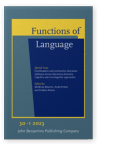Introduction published In:
Continuative and contrastive discourse relations across discourse domains: Cognitive and cross-linguistic approachesEdited by Matthias Klumm, Anita Fetzer and Evelien Keizer
[Functions of Language 30:1] 2023
► pp. 4–15
